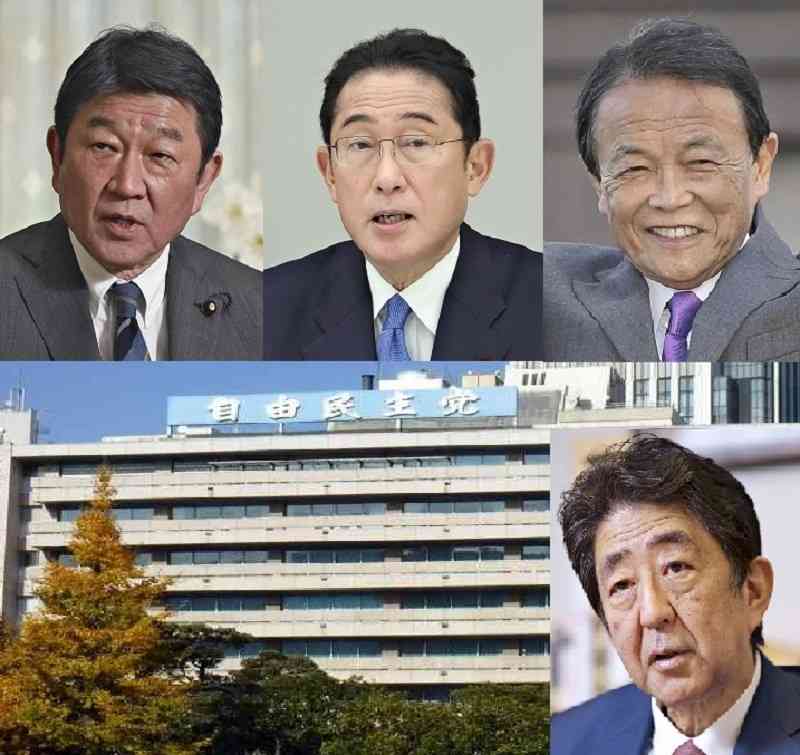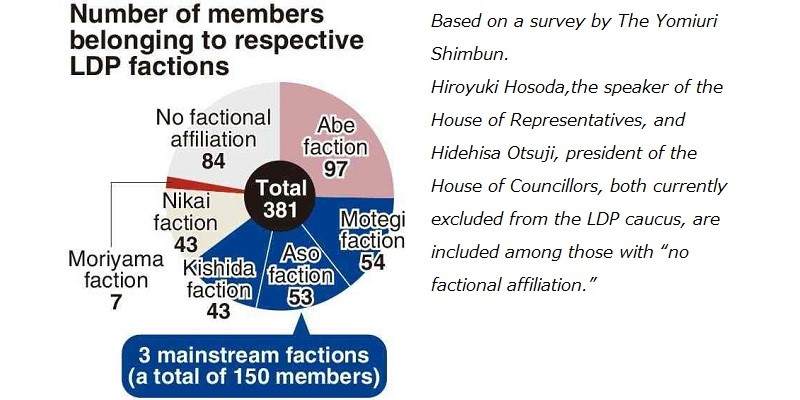Kishida’s first-year report card / Balance of power within LDP of key importance

Clockwise from top left: Liberal Democratic Party Secretary General Toshimitsu Motegi, Prime Minister Fumio Kishida, LDP Vice President Taro Aso, former Prime Minister Shinzo Abe and the LDP headquarters building
1:00 JST, October 10, 2022
Prime Minister Fumio Kishida’s Cabinet has passed the first anniversary of its inauguration with its approval rating on the decline. This series examines how Kishida’s political style so far has affected the handling of key issues and what the future holds for his administration.
***
On Sept. 13, Prime Minister Fumio Kishida —who also serves as head of the Liberal Democratic Party — met with Liberal Democratic Party Vice President Taro Aso and Secretary General Toshimitsu Motegi at the party headquarters to discuss lower house redistricting.
Previously, the Council on the House of Representatives Electoral District had recommended the adoption of a “plus 10, minus 10” plan to create 10 new constituencies while eliminating 10 others. Many within the party opposed the idea — in particular, lawmakers elected from the 10 prefectures that would be affected by the “minus 10” part of the plan— prompting Motegi to briefly consider revising the initiative.
“Resistance to the idea is overwhelming,” Motegi said, according to sources. “But some party members quietly insist that the government will experience harsh public criticism unless it implements the plan as recommended.”
Kishida reportedly replied: “I hear some people are wondering if arbitrary modification would be acceptable.”
After an about 50-minute meeting, they three pols decided it would be difficult to modify the recommended plan and agreed to carefully follow intraparty procedures so as not to rush the idea through forcefully. Aso is said to have given a silent nod.
The “plus 10, minus 10” plan was derived by applying the 2020 population census to a calculation formula specified by a law established in 2016 at the initiative of the LDP. The government plans to submit a bill to revise the Public Offices Election Law to change the current constituency zoning in line with the recommendation.
Kishida, Motegi and Aso anticipated difficulties with internal party discussions, but ultimately were concerned that any modification to the bill would result in public criticism and be perceived as a selfish party ploy.
The three men — all of whom have served as faction presidents — have met as often as four times a month since Kishida appointed Motegi in November. Some have referred to their now well-established decision-making style as a “triumvirate,” in reference to the three-way political alliances of the ancient Roman Republic.
The same day, the trio also reportedly discussed the Cabinet’s waning approval rating. Aso attempted to cheer Kishida by saying, “As long as my group [the Aso faction] and the Kochikai group [the Kishida faction] stay firm and strong, everything will be fine.”
‘Ellipse theory’
Kishida, Aso and Motegi are trying to dominate the party only through their factions. There are many cases in which the three make policy decisions, but Kishida then explains the matters to other senior party officials. In his first year of office, Kishida has visited party headquarters 81 times, far more frequently than former Prime Minister Yoshihide Suga, who made 40 visits in total, and former Prime Minister Shinzo Abe, who made 14 visits during the last year of his tenure.
Furthermore, Kishida has put extra priority on his relationship with the Abe faction, the party’s largest faction, which includes almost 25% of LDP members.
As party president, Kishida has adopted “ellipse theory” as a basic management concept. The theory is premised on achieving overall harmony by balancing two centers. This political philosophy was championed by former Prime Minister Masayoshi Ohira, one of the pioneering leaders of the Kochikai group — now the Kishida faction.
For Kishida, one of these centers is the three mainstream factions — headed respectively by himself, Aso and Motegi — while the other center is the Abe faction, which represents conservative lawmakers. Kishida deems it essential to keep these two poles in equilibrium.
Kishida has occasionally compromised to maintain this balance, exemplified by his approach to the Basic Policy on Economic and Fiscal Management and Reform, which was approved during a Cabinet meeting in June. In keeping with a request from Abe, the document specifies a timeframe of “within five years” to strengthen the nation’s defense capabilities. Abe, for his part, kept a lid on dissatisfaction within his faction over Kishida.
Vacant post
The Abe faction has been unstable since Abe’s shooting death in July.
On the night of Sept. 29, senior faction members and lower house faction members elected six or more times gathered at a Chinese restaurant in the Ginza district of Tokyo.
During a general meeting of the faction earlier that day, acting chairman Ryu Shionoya said he was considering electing a leader to fill the vacant post. But no one talked about a new leader at the dinner, which was attended by possible rivals to Shionoya, including Hakubun Shimomura, another acting chairman, and Koichi Hagiuda, chairman of the LDP Policy Research Council.
As the dinner concluded, however, Seishiro Eto — the faction’s supreme advisor and one of its longest-standing members — said the vacant post might go to Shionoya. No one applauded in agreement or voiced opposition, and the room reportedly took on awkward atmosphere. Attendees then reportedly heard someone say, “No, I don’t agree.”
Later, one disgruntled attendee said, “Those keen to lead the faction were trying to keep their rivals in check.”
Some hardline voices within the faction insist it should field a candidate in the next LDP presidential election. But there are also concerns that the Abe faction could split over who should succeed Abe, which might trigger political uncertainty within the party.
With one elliptical center already wobbling, future management of the party has become opaque. Kishida is now doing his utmost to keep his party from fracturing.






